Sorry. I can’t stop myself. Here’s the best picture yet of a red squirrel. If ever there was a reason to protect the Reds, it’s their supersonic selfdom. Though this one looks wily enough to defeat the Pox.
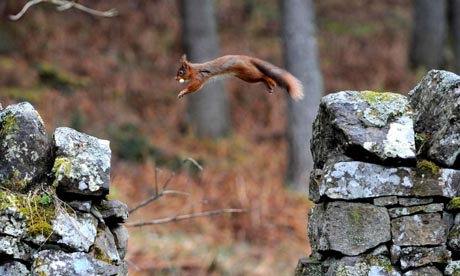

ANIMALS, PEOPLE AND THOSE IN BETWEEN
Sorry. I can’t stop myself. Here’s the best picture yet of a red squirrel. If ever there was a reason to protect the Reds, it’s their supersonic selfdom. Though this one looks wily enough to defeat the Pox.

I’m not sorry that the squirrel-human gyre keeps widening.
There was apparently a time, not long ago, that the Squirrel Clubs of the Scottish Highlands had their sites on the Reds.
This week the BBC published in a historical report, ‘Send Me Tails of Red Squirrels’ that
…from 1903, there was an active effort on estates across the Highlands to trap, shoot and kill reds.
By 1946, the Highland Squirrel Club had killed 102,900 squirrels and paid out £1,504 in bounties.
Tails were submitted as proof of kills.
There are several ironies in the story of the club, which was formed in 1903.
Reds were extinct, or on the brink of extinction, in the Highlands by the 1800s because of a loss of woodland habitat.
In 1844, Lady Lovat of Beaufort Estate near Beauly, succeeded in getting the government to re-introduce the squirrels to the Highlands.
Ian Collier, of the Highland Red Squirrel Group – a modern day organisation set up to protect reds – believed the creatures were seen by some owners of “big houses” as a “fashion accessory” to add to their landscaped gardens.
Mr Collier said: “What is ironic is that many of the red squirrels were re-introduced from England, now among the worst-hit areas for squirrel pox, which kills reds.
“Other reds were introduced from populations in Sweden.”
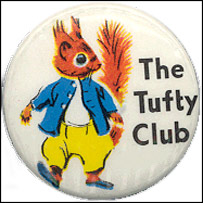 Friend Richard O’Flynn (whom I will ask for a close reading) alerted me to the 1973 UK Public Information Films of Tufty the Red Squirrel. BBC News published a tribute to Tufty in 2006:
Friend Richard O’Flynn (whom I will ask for a close reading) alerted me to the 1973 UK Public Information Films of Tufty the Red Squirrel. BBC News published a tribute to Tufty in 2006:
Tufty is a colossus of public information. Though just a small squirrel, he was a phenomenon who bestrode childhoods from the early 1960s onwards. Through very simple films, books and stories, Tufty persuaded pre-school children that the road could be a dangerous place. This was done through the medium of burst footballs and dropped ice-creams, rather than something which young eyes might find too upsetting, such as squashed squirrels.
The comments at the end of the article include some melancholic reminiscences of childhood, related to Tufty’s vivid lessons –
I was traumatized by a Tufty experience as a child when I lived in Cheshire. I SO wanted to join the Tufty Club and after many attempts I persuaded my Mum to take me to enrol. I was devastated to learn that I was too old (aged 8). I have never fully recovered from this disappointment
Claire, Fort Wayne, Indiana, US
Here’s the clip called “Ice Cream”:
Best of Tufty can be seen here;
and here, of course, is Tufty with suggestive overdubs.
Sadly, these are some of the new Tufty products put out by the RoSPA (The Royal Society for the Prevention of Accidents) … for all your safety needs:
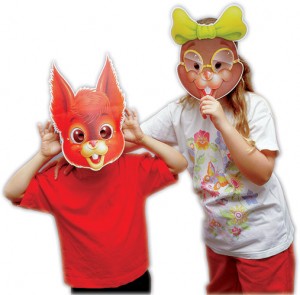
A set of colourful Tufty character masks, with simple instructions and teaching notes. Children can pretend to be their favourite character – Tufty, Willy, Becky, Minnie, Mrs Owl or Policeman Badger.
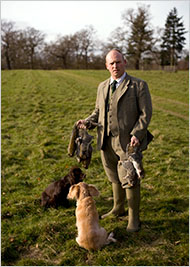
A few morsels from the New York Times’ January 2009 article on “Saving a Squirrel by Eating One” article. If you are so enchanted as to sample the cute critters, the last excerpt certainly puts a dent in the argument for delighting in consumption:
Enter the “Save Our Squirrels” campaign begun in 2006 to rescue Britain’s red squirrels by piquing the nation’s appetite for their marauding North American cousins. With a rallying motto of “Save a red, eat a gray!” the campaign created a market for culled squirrel meat.
British bon vivants suddenly couldn’t get enough squirrel. Television chefs were preparing it, cookbooks were extolling it, farmers’ markets were selling out of it and restaurants in many places were offering it on the menu.
Nichola Fletcher, a food writer and co-owner of a venison farm, held a squirrel tasting for Britain’s Guild of Food Writers, finding “their lovely flavor tasted of the nuts they nibbled.” At a later event, however, she found the flavor disappointing, with “a greasy texture and unpleasant taste,” presumably reflecting these squirrels’ diet.
Fergus Henderson…who cooks with both poetry and passion, sometimes prepares his squirrels “to recreate the bosky woods they come from,” braising them with bacon, “pig’s trotter, porcini and whole peeled shallots to recreate the forest floor.” He serves it with wilted watercress “to evoke the treetops.”
Other chefs may be less lyrical, but they are no less enthusiastic. The Famous Wild Boar Hotel in Britain’s Lake District serves squirrel Peking-duck style; at Matfen Hall, a grand country house hotel, it is layered with hazelnuts into a terrine; in Cornwall, it can be found baked into the iconic meat pie known as a pasty.
If you want to grab your shotgun, make sure you have very good aim — squirrels must be shot in the head; a body shot renders them impossible to skin or eat. (You want to get rid of the head in any event, as squirrel brains have been linked to variant Creutzfeldt-Jakob disease, the human form of mad cow disease.)
Not such new news, though. This article from the Telegraph in June 2005:
A restaurant selling squirrel terrine has been forced to withdraw it after death threats from animal rights activists.Protesters threatened to firebomb the Hadley Bowling Green Inn in Droitwich, Worcs, and to smash up the staff’s cars over the £7.95 paté starter.
A female housekeeper was told: “I’m glad I don’t work here because I wouldn’t want to die in the fire.”
After the dish was featured on local television the restaurant received about 25 threatening telephone calls and a string of malicious e-mails.
Its spokesman, Barney Reynolds, said: “The last thing we would want to do is to pander to this sort of intimidation.
“But the fact is that some of the staff were coming into work fearing for their lives.”
He added: “We’ve never had to take something off the menu before because of threats from protesters. I don’t know why squirrel meat is so controversial.
“In the past we’ve sold meat from fluffy little lambs and it’s not been a problem.”
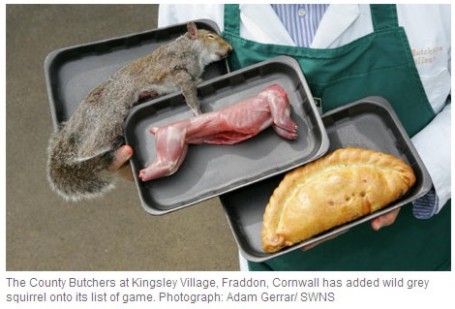
Squirrels.
Imagine them:
Red feather headdresses
versus gray flannel suits
of the Wall Street reivers.
Landgrabbing American Grays – purveyors of squirrel
pox pockets – turn little Reds into sludge.
BRITAIN’S FAVORED NATIVES SACKED BY IMMIGRANTS, say headlines;
diseases carrying foreigners, or foreigners carrying disease – either way.
Like Mayflower, like Ailanthus, they come with fanfare, as
idealists or ornamentals; these nature-shifter parasites enthuse wildly. And they
don’t share. Great Northumbrian verminators in camouflage are on a killing spree,
mandating: Do your part, Britain! Gray squirrel loin is hardly greasy or unpleasant…
In an effort to save the native Red Squirrel, the invasive Gray Squirrel in the UK been subject to a holocaust (esp in Northumbria, the last stronghold of the reds): Over 20,000 Gray Squirrels are Culled. Gray Squirrels were brought over from America in the early 19th century “to amuse the rich;” now they’ve gotten out of hand, and the native Red (arguably the cuter, daintier and foxier of the two species) is close to extinction.
There was a Channel 4 doc about the battle.
Chicago Sun Times summed up the problem pithily:
“…consider now the British red squirrel, a vibrant, cheeky little creature whose scarlet coat simply glows. The sad truth of the matter is that the big, pushy American gray squirrel is taking over and causing marked species decline.“The red squirrel is native to Britain, but its future is increasingly uncertain as the introduced American gray squirrel expands its range across the mainland. There are estimated to be only 140,000 red squirrels left in Britain, with over 2.5 million grays. The Forestry Commission is working with partners in projects across Britain to develop a long-term conservation strategy that deters grays and encourages reds.”
The red squirrel may be an English icon, just like a red fox, but it is dying out here in Great Britain, as the above Forestry Commission report makes clear. This is hardly a new phenomenon. I think of Bill Bryson’s excellent Australia travel book, In a Sunburnt Country, which documents case after case of species annihilation caused by the introduction of Western plants and animals.
This time, though, the little red British squirrel is at the mercy of the behemoth American gray. Of course the culture critics can make all sorts of fun metaphors with that one. But I see this phenomenon as more of a scientific fact of life, albeit one that I hope we can alter. So I cheer on the underdog red squirrel, especially the cute ones that scampered under our lodge window in the Scottish Highlands, snatching up the peanuts we put out for them and running up the nearby silver birch to crack into the shells as we cheered from within.” – http://blogs.suntimes.com/fosnight/2008/02/red_squirrel_versus_grey_squir.html
A choice commentator elsewhere called the grays “foreign interlopers, not even European.’
Rife with potential analogies and clear subtexts, the (American) Gray Squirrel is a virus carrier, to which it is immune. With its arsenal of squirrelpox and its talent for landgrabbing, it has succeeded in exterminating most of the UK Reds.
So, the Gray Squirrel is being culled.
In Northern England, there is a force called the Red Squirrel Protection Unit, founded by the 6th Baron Redesdale of Northumberland (The Baron has a lengthy profile for his squirrely patriotism in the New York Times, 2007).
I found out that at least his co-founder, the verminator Paul Parker eats the culled Grays.
‘We developed what we called our killing strategy. Hit them in the woods. Dipton Woods: we took 2,000 out. If you clear a woodland you suck all the surrounding population to it. Then you hit them again. Suck ’em in, hit them.’ – The Guardian
One of the Red Squirrel protection unit culling gray squirrels in Northumberland.
Photograph: Gary Galton
red squirrels, after all, are not scarce outside the British Isles. In fact, worldwide — reds live throughout Europe and Asia — they probably outnumber grays. It is only in Britain (and more recently in Italy, where grays were introduced in 1948) that the red is considered threatened.
